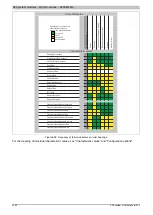
X20 system modules • Other functions • X20CM4810
X20 system User's Manual 3.10
2107
Kurtosis
Kurtosis is an effective characteristic value for assessing the number of peaks in a signal. Kurtosis (peakedness,
fourth statistical moment) is defined as the ratio of two statistical characteristic values/processes.
Kurtosis is a type of weighted "Crest factor". The signal peaks are valued higher than the "signal noise" (also called
the carpet value) due to the fourth power of the integral. Not only is the RMS value also used, but the entire signal
progression as well. This increases the informational value of this characteristic value.
Information:
Kurtosis is standardized at zero in the X20CM4810 module.
A kurtosis factor of less than two is typical of a machine in good condition.
KurtosisRaw
The kurtosis factor formed from the raw signal of the oscillation acceleration up until the configured maximum
frequency ("MaxFrequencyRaw01") of the respective channel.
Example:
Suboptimal lubrication of fans
Skewness factor
The skewness factor (skewness, third statistical moment) specifies the degree of a signal's asymmetry in reference
to its standard distribution. The lower the skewness, the more evenly distributed the signal. A signal with a high
skewness factor has a much larger amplitude in the assessment range.
A symmetrically distributed signal has a skewness factor of 0. Depending on the direction of the slant, the skewness
can be positive or negative. A considerable slant means approximately a skewness factor of ±1.
A large kurtosis factor combined with a large skewness factor indicates electrostatic discharge.
SkewnessRaw
Skewness factor formed from the raw signal of the oscillation acceleration up until the configured maximum fre-
quency ("MaxFrequencyRaw01") of the channel.
Example:
Determining the belt tension and belt alignment in flat belts and V-belts
Description of frequency bands
For the early detection of damage and problems, it is often useful to monitor individual frequency bands. A selective
RMS value can be used as the characteristic value for these frequency bands.
Possibilities:
•
•
•
Up to 32 different frequency bands can be defined. The center frequency and the frequency intervals are defined
in terms of the upper and lower limits. It is important to note that the format varies slightly depending on the
configuration (see section 4.26.2.2.11 "Characteristic value format" on page 2075).
Speed-dependent RMS
Am
pl
itu
de
Frequency
1)
- 2)
+ 2)
Frequency band
Frequency broadband is formed from the speed frequency ± the frequency interval.
1)
Speed frequency:
"FrequencyBandxxDmgFreq60Rpm" * "ActSpeed"
2)
Frequency interval:
Non speed-dependent RMS






























